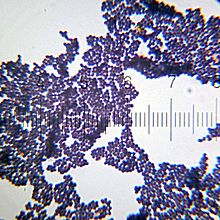Facts for Kids
Staphylococcus is a genus of Gram-positive bacteria that can be helpful or harmful to humans, often found on our skin and in our noses.
Overview
Prevention Measures
Laboratory Diagnosis
Role In Human Microbiome
Pathogenicity And Diseases
Taxonomy And Classification
Morphology And Characteristics
Transmission And Infection Control
Treatment And Antibiotic Resistance
Interesting Facts And Historical Significance

Inside this Article
Staphylococcus Aureus
Infection
Community
Alexander
Bacteria
Medicine
Nature
Oxygen
Blood
Are
Did you know?
🔬 Staphylococcus is a group of tiny bacteria that you need a microscope to see.
💜 They are called 'Gram-positive' because they take up a special dye, making them look purple under a microscope.
🌍 You can find Staphylococcus bacteria on our skin and in our noses.
🥚 These bacteria are round and can appear in clusters like grapes.
😷 Some types, like Staphylococcus aureus, can cause sickness.
🦸♂️ Staphylococcus can survive in different environments because they do not require oxygen.
🦠 They can spread easily through contact with infected people or contaminated surfaces.
💊 Doctors often use antibiotics to treat Staphylococcus infections, but some have become resistant.
😊 Many Staphylococcus species help protect our bodies and are part of our microbiome.
🕰️ Scientists have been studying Staphylococcus for over 150 years!
Introduction
They are called "Gram-positive," which means they take up a special dye that makes them look purple under the microscope. Staphylococcus bacteria are usually found on our skin and in our noses. They come in different types; some are helpful, while others can make us sick! Understanding how these little creatures work can help us stay healthy. Staphylococcus can be found almost everywhere, like in the air we breathe and the surfaces we touch! 🌍
Prevention Measures
Always scrub with soap for at least 20 seconds. It’s also good to keep cuts clean and covered to avoid germs getting in. 🩹
If you're at school or a playground, be careful not to share personal stuff like towels or razors. If someone has a Staphylococcus infection, remind them to stay home and rest until they're better. Taking these steps helps keep everyone healthy and safe!
Laboratory Diagnosis
One common way is by taking a sample from the infected area, like a cut or sore. This sample is then placed on a special dish called a Petri dish to see if bacteria grow! If they see purple colonies, it might be Staphylococcus! Doctors can also do blood tests to check if the bacteria are in the bloodstream. 🔬
These tests help doctors decide the best way to treat the infection.
Role In Human Microbiome
They help protect against harmful microbes and can support our immune system. For example, Staphylococcus epidermidis is one of the good ones and helps protect our skin from infections. We have a whole community of these bacteria working hard for us, like little invisible superheroes! 🦸
♀️
Pathogenicity And Diseases
Did you know that around 30% of people carry S. aureus without getting sick? However, if it gets into a cut or wound, it can become dangerous. Patients with weakened immune systems are more likely to get sick from these bacteria. Always washing your hands helps keep these bad guys at bay! 🧼
Taxonomy And Classification
This group is divided into different types called "species." The most famous one is Staphylococcus aureus, which can cause sickness. Some others include Staphylococcus epidermidis, which usually helps protect our skin! Each type has its special job, just like how different animals have different roles in nature. 🦁
For example, some can behave like friendly bacteria, while others can be the "bad guys" that cause infections.
Morphology And Characteristics
These bacteria have a thick outer wall that helps protect them. They don’t need oxygen to survive, which is why they can live in lots of different places—like under our skin! Staphylococcus species can grow in warm environments, making our bodies a perfect home. They are also resilient, meaning they can survive harsh conditions, just like superheroes! 🦸
♂️
Transmission And Infection Control
You can get them through direct contact with someone who is infected or by touching contaminated surfaces. For example, if someone with a cut accidentally touches a doorknob and you do too, those germs can jump to you! That's why cleaning your hands often and not sharing personal items, like towels, is super important. 🛁
Hospitals are careful, too, because they want to keep patients safe from Staphylococcus infections. Using gloves and cleaning tools helps stop the spread!
Treatment And Antibiotic Resistance
But some Staphylococcus bacteria have become resistant to certain antibiotics, making them harder to treat. This means that not all medicines work on these bacteria anymore! One really tough type is called MRSA (Methicillin-resistant Staphylococcus aureus). 🦠
It's essential for doctors to understand these bacteria to give the right medicine. So, it’s crucial to use antibiotics wisely!
Interesting Facts And Historical Significance
️ In the 1880s, a bacteriologist named Sir Alexander Ogston discovered Staphylococcus aureus after investigating an outbreak of skin infections. 📜
Additionally, due to its ability to become resistant to antibiotics, Staphylococcus has become a key focus for doctors and scientists in battles against germs. Learning about Staphylococcus helps us understand how to stay healthy and combat infections! 🦠

